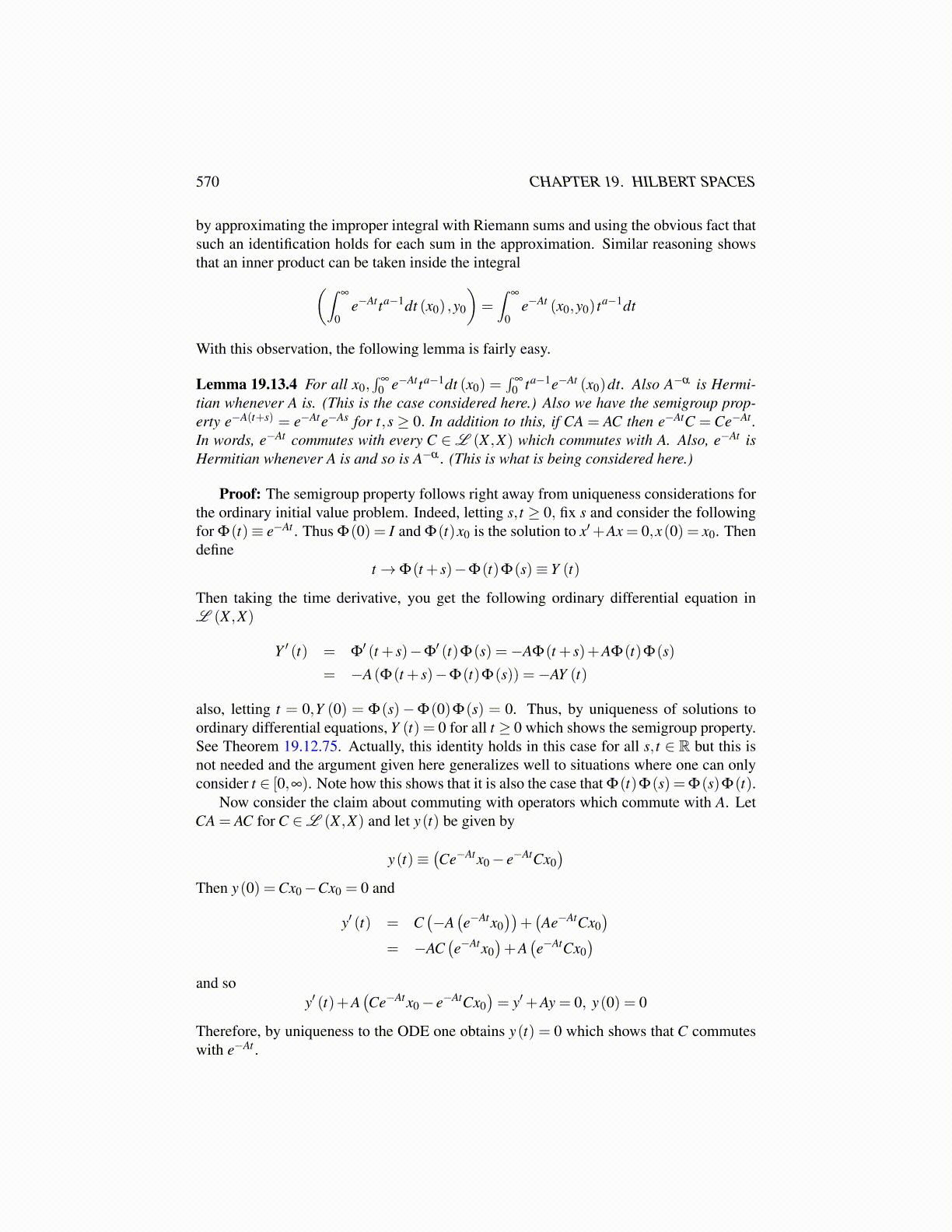
570 CHAPTER 19. HILBERT SPACES
by approximating the improper integral with Riemann sums and using the obvious fact thatsuch an identification holds for each sum in the approximation. Similar reasoning showsthat an inner product can be taken inside the integral(∫
∞
0e−Atta−1dt (x0) ,y0
)=∫
∞
0e−At (x0,y0) ta−1dt
With this observation, the following lemma is fairly easy.
Lemma 19.13.4 For all x0,∫
∞
0 e−Atta−1dt (x0) =∫
∞
0 ta−1e−At (x0)dt. Also A−α is Hermi-tian whenever A is. (This is the case considered here.) Also we have the semigroup prop-erty e−A(t+s) = e−Ate−As for t,s ≥ 0. In addition to this, if CA = AC then e−AtC = Ce−At .In words, e−At commutes with every C ∈L (X ,X) which commutes with A. Also, e−At isHermitian whenever A is and so is A−α . (This is what is being considered here.)
Proof: The semigroup property follows right away from uniqueness considerations forthe ordinary initial value problem. Indeed, letting s, t ≥ 0, fix s and consider the followingfor Φ(t)≡ e−At . Thus Φ(0) = I and Φ(t)x0 is the solution to x′+Ax = 0,x(0) = x0. Thendefine
t→Φ(t + s)−Φ(t)Φ(s)≡ Y (t)
Then taking the time derivative, you get the following ordinary differential equation inL (X ,X)
Y ′ (t) = Φ′ (t + s)−Φ
′ (t)Φ(s) =−AΦ(t + s)+AΦ(t)Φ(s)
= −A(Φ(t + s)−Φ(t)Φ(s)) =−AY (t)
also, letting t = 0,Y (0) = Φ(s)−Φ(0)Φ(s) = 0. Thus, by uniqueness of solutions toordinary differential equations, Y (t) = 0 for all t ≥ 0 which shows the semigroup property.See Theorem 19.12.75. Actually, this identity holds in this case for all s, t ∈ R but this isnot needed and the argument given here generalizes well to situations where one can onlyconsider t ∈ [0,∞). Note how this shows that it is also the case that Φ(t)Φ(s) = Φ(s)Φ(t).
Now consider the claim about commuting with operators which commute with A. LetCA = AC for C ∈L (X ,X) and let y(t) be given by
y(t)≡(Ce−Atx0− e−AtCx0
)Then y(0) =Cx0−Cx0 = 0 and
y′ (t) = C(−A(e−Atx0
))+(Ae−AtCx0
)= −AC
(e−Atx0
)+A
(e−AtCx0
)and so
y′ (t)+A(Ce−Atx0− e−AtCx0
)= y′+Ay = 0, y(0) = 0
Therefore, by uniqueness to the ODE one obtains y(t) = 0 which shows that C commuteswith e−At .